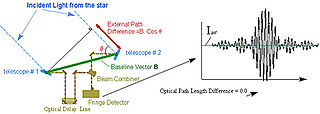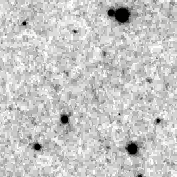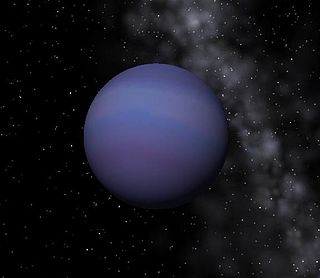Related Research Articles

Astrometry is a branch of astronomy that involves precise measurements of the positions and movements of stars and other celestial bodies. It provides the kinematics and physical origin of the Solar System and this galaxy, the Milky Way.

Barnard's Star is a small red dwarf star in the constellation of Ophiuchus. At a distance of 5.96 light-years (1.83 pc) from Earth, it is the fourth-nearest-known individual star to the Sun after the three components of the Alpha Centauri system, and the closest star in the northern celestial hemisphere. Its stellar mass is about 16% of the Sun's, and it has 19% of the Sun's diameter. Despite its proximity, the star has a dim apparent visual magnitude of +9.5 and is invisible to the unaided eye; it is much brighter in the infrared than in visible light.

Teegarden's Star is an M-type red dwarf in the constellation Aries, 12.5 light-years from the Solar System. Although it is near Earth it is a dim magnitude 15 and can only be seen through large telescopes. This star was found to have a very large proper motion of about 5 arcseconds per year. Only seven stars with such large proper motions are currently known.

Lalande 21185 is a star in the south of Ursa Major. It is the apparent brightest red dwarf in the northern hemisphere. Despite this, and being relatively close by, it is very dim, being only magnitude 7.5 in visible light and thus too faint to be seen with the unaided eye. The star is visible through a small telescope or binoculars.

Hipparcos was a scientific satellite of the European Space Agency (ESA), launched in 1989 and operated until 1993. It was the first space experiment devoted to precision astrometry, the accurate measurement of the positions of celestial objects on the sky. This permitted the first high-precision measurements of the intrinsic brightnesses, proper motions, and parallaxes of stars, enabling better calculations of their distance and tangential velocity. When combined with radial velocity measurements from spectroscopy, astrophysicists were able to finally measure all six quantities needed to determine the motion of stars. The resulting Hipparcos Catalogue, a high-precision catalogue of more than 118,200 stars, was published in 1997. The lower-precision Tycho Catalogue of more than a million stars was published at the same time, while the enhanced Tycho-2 Catalogue of 2.5 million stars was published in 2000. Hipparcos' follow-up mission, Gaia, was launched in 2013.

Piet van de Kamp, known as Peter van de Kamp in the United States, was a Dutch astronomer who lived in the United States most of his life. He was professor of astronomy at Swarthmore College and director of the college's Sproul Observatory from 1937 until 1972. He specialized in astrometry, studying parallax and proper motions of stars. He came to public attention in the 1960s when he announced that Barnard's star had a planetary system based on observed "wobbles" in its motion, but this is now known to be false. On November 14, 2018, the Red Dots project announced that Barnard's star hosts an exoplanet at least 3.2 times as massive as Earth, though this does not match either of the planets he had claimed. In 2021, even this planet's existence was questioned.

Van Maanen 2, or van Maanen's Star, is the closest known solitary white dwarf to the solar system. It is a dense, compact stellar remnant no longer generating energy and has equivalent to about 68% of the Sun's mass but only 1% of its radius. At a distance of 14.1 light-years it is the third closest of its type of star after Sirius B and Procyon B, in that order. Discovered in 1917 by Dutch–American astronomer Adriaan van Maanen, Van Maanen 2 was the third white dwarf identified, after 40 Eridani B and Sirius B, and the first solitary example.

Rho Coronae Borealis is a yellow dwarf star 57.1 light-years away in the constellation of Corona Borealis. The star is thought to be similar to the Sun with nearly the same mass, radius, and luminosity. It is orbited by four known exoplanets.
Ross 614 is a red dwarf UV Ceti flare star and it is the primary member of a nearby binary star system in the constellation of Monoceros. This star has a magnitude of about 11, making it invisible to the unaided eye even though it is one of the stars nearest to the Sun. This system is among the closest to the Sun at an estimated distance of about 13.3 light years. Because this star is so close to the Earth it is often the subject of study, hence the large number of designations by which it is known.

16 Cygni Bb or HD 186427 b is an extrasolar planet approximately 69 light-years away in the constellation of Cygnus. The planet was discovered orbiting the Sun-like star 16 Cygni B, one of two solar-mass (M☉) components of the triple star system 16 Cygni in 1996. It orbits its star once every 799 days and was the first eccentric Jupiter and planet in a double star system to be discovered. The planet is abundant in lithium.

109 Piscium b is a long-period extrasolar planet discovered in orbit around 109 Piscium. It is about 5.74 times the mass of Jupiter and is likely to be a gas giant. As is common for long-period planets discovered around other stars, it has an orbital eccentricity greater than that of Jupiter.
Gliese 86 is a K-type main-sequence star approximately 35 light-years away in the constellation of Eridanus. It has been confirmed that a white dwarf orbits the primary star. In 1998 the European Southern Observatory announced that an extrasolar planet was orbiting the star.
HD 190228 is a star with a substellar companion in the constellation Vulpecula. Its apparent magnitude is 7.30 – too faint to be seen with the naked eye – and the absolute magnitude is 3.34. Based on parallax measurements, it is located at a distance of 205 light-years from the Sun. The star is older than the Sun with an age over 5 billion years and it is metal-poor.

Gliese 86 b, sometimes referred to as Gliese 86 A b and/or shortened to Gl 86 b, is an extrasolar planet approximately 35 light-years away in the constellation of Eridanus. The planet was discovered orbiting a K-type main-sequence star by French scientists in November 1998. The planet orbits very close to the star, completing an orbit in 15.78 days.
HD 192263 b is a gas giant planet with a mass about three quarters that of Jupiter mass. It orbits the star in a circular orbit completing one revolution in 24 days or so. It was discovered in 2000 by the Geneva Extrasolar Planet Search team. The planet was independently detected by the California and Carnegie Planet Search team.
Sarah Lee Lippincott, also known as Sarah Lee Lippincott Zimmerman, was an American astronomer. She was professor emerita of astronomy at Swarthmore College and director emerita of the college's Sproul Observatory. She was a pioneer in the use of astrometry to determine the character of binary stars and search for extrasolar planets.

Bonnard John Teegarden is an American astrophysicist formerly with NASA's Goddard Space Flight Center, now retired. He spent most of his career studying cosmic gamma rays and is best known to the public for leading the team that discovered Teegarden's star in 2003.
Innes' star is an M3.5-type red dwarf, located in constellation Carina. It has around 35% of the mass of the Sun, yet only 1.1% of its luminosity, and an estimated surface temperature of 3,323 K.
References
- ↑ "George G. Gatewood". University of Pittsburgh. Archived from the original on 2008-12-27. Retrieved 2009-05-31.
- ↑ Gatewood, George David (1972). An Astrometric Study of Barnard's Star. Bibcode:1972PhDT.........5G.
{{cite book}}:|work=ignored (help) - ↑ John L. Hershey (1973). "Astrometric analysis of the field of AC +65 6955 from plates taken with the Sproul 24-inch refractor". The Astronomical Journal . 78 (6): 421. Bibcode:1973AJ.....78..421H. doi: 10.1086/111436 .
- ↑ Gatewood; Eichhorn, H. (October 1973). "An unsuccessful search for a planetary companion of Barnard's star BD +4°3561". The Astronomical Journal . 78: 769–776. Bibcode:1973AJ.....78..769G. doi: 10.1086/111480 .
- ↑ Gatewood, G. (1974). "An astrometric study of Lalande 21185". The Astronomical Journal . 79: 52–53. Bibcode:1974AJ.....79...52G. doi:10.1086/111530.
- ↑ Gatewood, G. (May 1996). "Lalande 21185". Bulletin of the American Astronomical Society. 28: 885. Bibcode:1996AAS...188.4011G.
- ↑ John Wilford (1996-06-12). "Data Seem to Show a Solar System Nearly in the Neighborhood". The New York Times . p. 1. Retrieved 2009-05-29.
- ↑ Gatewood; Stein, John; De Jonge, Joost K.; Persinger, Timothy; Reiland, Thomas; Stephenson, Bruce (September 1992). "Multichannel astrometric photometer and photographic astrometric studies in the regions of Lalande 21185, BD 56°2966, and HR 4784". The Astronomical Journal . 104 (3): 1237–1247. Bibcode:1992AJ....104.1237G. doi: 10.1086/116313 .
- ↑ Henry; Baliunas, Sallie L.; Donahue, Robert A.; Fekel, Francis C.; Soon, Willie (March 1, 2000). "Photometric and Ca II H and K Spectroscopic Variations in Nearby Sun-like Stars with Planets. III". The Astrophysical Journal. 531 (1): 415–437. Bibcode:2000ApJ...531..415H. doi: 10.1086/308466 . S2CID 17737644.
- ↑ Vernor Vinge (1986). Marooned in Realtime. Bluejay Books/St. Martin's Press.
- ↑ Gatewood, G. (1980). In Search of Extrasolar Planets. p. 12. Bibcode:1980CosSe...2...12G.
{{cite book}}:|work=ignored (help) - ↑ George Gatewood, Louis Coban (January 2009). "Allegheny Observatory Parallaxes for Late M Dwarfs and White Dwarfs". The Astronomical Journal . 137 (1): 402–405. Bibcode:2009AJ....137..402G. doi: 10.1088/0004-6256/137/1/402 .
- ↑ "Archived copy". Archived from the original on 2006-09-16. Retrieved 2009-09-05.
{{cite web}}: CS1 maint: archived copy as title (link) - ↑ "George G. Gatewood | Physics & Astronomy". Archived from the original on 2008-12-27. Retrieved 2009-05-31.